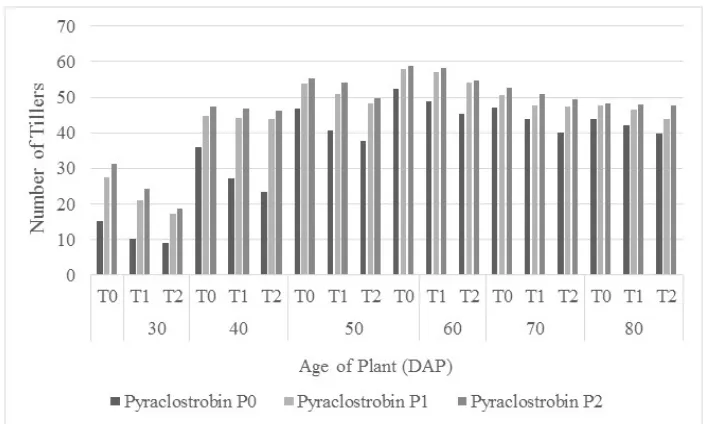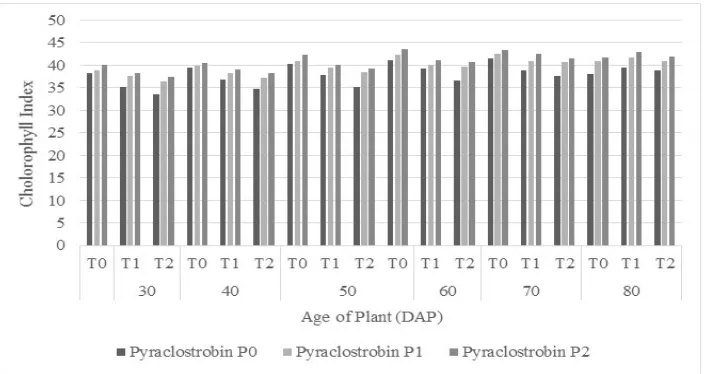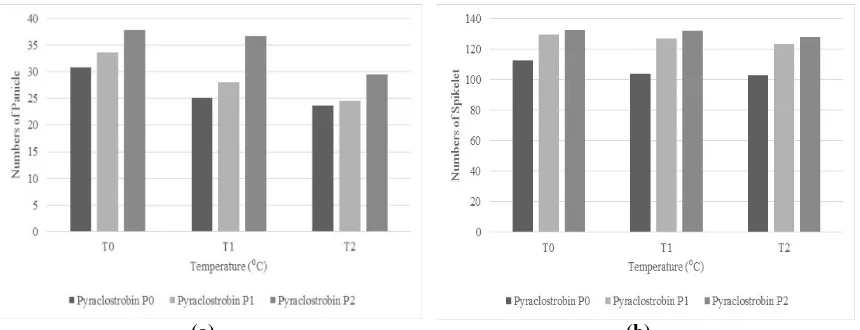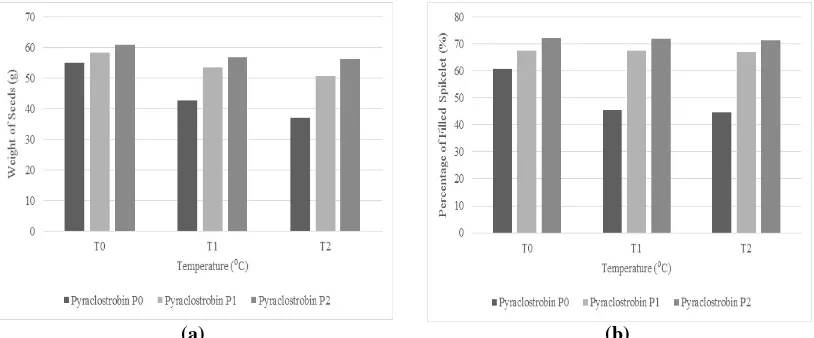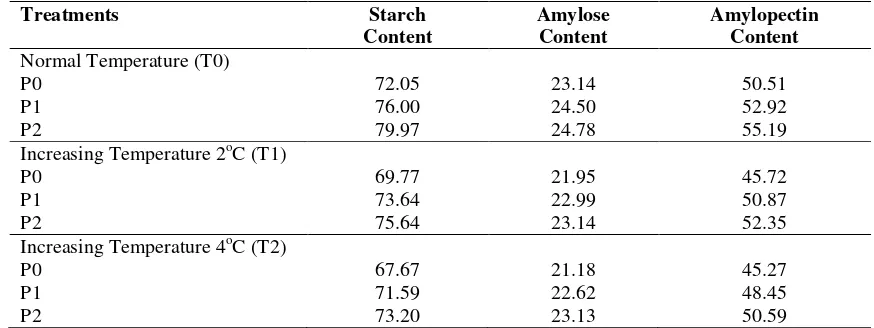ISSN: 2339-076X (p); 2502-2458 (e)
,
Volume 3, Number 4 (July 2016): 663-669
DOI:10.15243/jdmlm.2016.034.663
Research Article
The response of rice (Oryza sativa
L.) to elevated night temperature
with application of
Pyraclostobin
T.Y. Wahjanto
1*, H.T. Sebayang
2, K. P. Wicaksono
21
Postgraduate Programme, Faculty of Agriculture, Brawijaya University, Jalan Veteran No. 1, Malang 65145 East Java, Indonesia
2
Faculty of Agriculture, Brawijaya University, Jalan Veteran No. 1, Malang 65145 East Java, Indonesia
* corresponding author : [email protected]
Abstract:
Rice productivity is having a problem related with climate change phenomenon, mainly the global warming. The rising of temperature in some country threat the rice production. The increasing of temperature is a major limiting factor that affects yield through the growth and development of rice plant. This study was aimed to examine the response of rice (Oryza sativaL.) to elevated night temperature with the application of Pyraclostobin. A glasshouse experiment that was conducted from March to August 2015 at Brawijaya University Research Station of Jatikerto – Malang, used nested plot design with three replications and two treatments. The first treatments were the night temperature level (normal temperature, increased 2oC, and increased 4oC). The second treatments were the concentration of Pyraclostrobin (0 ppm, 400 ppm and 800 ppm). Results of the study showed that the increase of temperature at night for about 2oC and 4oC, as well as application ofPyraclostrobin, affected growth and yield of rice. Application of Pyraclostrobin by concentrations of 400 ppm and 800 ppm effectively reduced yield loss by increasing night temperature of 2oC, which resulted in 20.20% and 24.93%, respectively, in comparison with the control; while the increase of night temperature by 4oC have resulted 26.86% and 33.33% in comparison with the control. Pyraclostrobin was effective in maintaining percentage of the filled spikelets by the increase of temperature at night for about 2oC and 4oC.Keywords:Pyraclostrobin,spikelet, temperatur increase
Introduction
Rice productivity has faced an obstacle that related to phenomenon of climate change, particularly global warming. The increasing temperature in some countries has become a threat for rice production. Such increasing temperature is the main limiting factor that affects yield of production, which affects development and growth rates of rice. The increasing temperature at night may trigger production, which causes oxidative stress on crops. The increasing may damage membrane of the crop that may cause respiration rate of the crops (Larrigaudiere et al., 2014).
As reported by Ambarkedar et al. (2011), the increasing temperature at night may disturb the metabolism process during the development phase of rice and affect both yield and quality
pre-and-post harvest. Hirai et al. (2003) stated that the increasing temperature at night might damage membranes of leaf, which automatically reduce the supply of assimilates for rice grains. Peng et al. (2004) suggested that each increasing 1oC might reduce yield of rice for about 10%.
Pyraclostrobinis a kind of fungicide that has double-actions, such as reducing drought / humidity and extreme temperature, as well as reducing the respiration rate of the crops on mitochondria. Besides that, it could increase the tolerant effect on any stress and increase physiological process of the crops (BASF, 2013). In order to find out the role ofPyraclostrobinon stress, the increasing temperature at night should be observed and reviewed by applying different dosages on rice (Oryza sativaL.).
toward the increase of temperature at night by different levels and to find out both growth and developmental responses of rice to the increase of temperature at night.
Materials and Methods
The study was conducted at Brawijaya University Research Station of Jatikerto – Malang from March to August 2015. The experiment that was laid out in a glasshouse used a nested design with three replications for each treatment. Treatments of night temperature included normal temperature at night, in which the rice was put outside the glasshouse without installation of heater lamp (T0), the increase of night temperature by 2
o
C using 9 lamps of 100 watt each (T1), and the
increase of night temperature by 4oC using 12 lamps of 100 watt each (T2). The type of lamp
used was incandescent lamp. Pyraclostrobin was at 30 and 60 days after planting rice. Growth parameters observed included numbers of tillers, chlorophyll index, age of flowering, and harvest. Yield parameters observed included numbers of panicle, numbers of spike per panicle, weight of seeds, and percentage of filled spikelet. Parameters of rice quality included starch content, amylose, and amylopectine. Data obtained were subjected to analysis of variance (F-test) by
significant level of 5%, followed by a Least Significant Difference test at a level of 5% on parameters of growth and yield of harvest.
Results and Discussion
Plant Growth
The increase of night temperature significantly reduced numbers of tillers. The increase of night temperature by 2oC and 4oC without application of Pyraclostrobin significantly reduced numbers of tillers at 40 to 70 DAP (days after planting) (Figure 1). Application of 800 ppm Pyraclostrobin on each treatment of temperature at night was effective to maintain numbers of tillers on stress condition. Baloch et al. (2006) reported that high temperature beyond optimal temperature for rice growth reduced the viability. Growth during the increased temperature at night may produce higher photosynthate at the cell elongation process in comparison with the formation of new tillers (Cheng et al., 2010). Mohammed and Tarpley (2009) also suggested that the vegetative phase is more sensitive than the reproductive phase under the increase of temperature condition.
Figure 1. Numbers of Tillers
The increases of temperature decreased the chlorophyll index. The increase of night temperature by 2oC along with the application of 400 ppm Pyraclostrobin significantly increased the chlorophyll index at 50 DAP and 70 DAP by 4.49% and 5.54%, respectively, in comparison
the chlorophyll index at 50 DAP, 60 DAP, and 70 DAP by 9.18%, 8.35% and 7.98%, respectively, in comparison with the control. Application of 800 ppm Pyraclostrobin significantly increased
chlorophyll index by 11.71%, 11.61% and 10.13% at 50 DAP, 60 DAP, and 70 DAP, respectively (Figure 2).
Figure 2. Chlorophyll Index
Muhammed and Tarpley (2009) suggested that the increase of night temperature beyond the optimal night temperature for the plant growth could decrease photosynthesis and chlorophyll index. In this study, rice grew well at 27.5oC to 30.4oC after the temperature increased 2oC and 4oC. The increase of temperature at night can increase ROS (reactive oxygen species) which may damage the leaf membrane, so that it affects the chlorophyll index and leaf function in producing assimilate and increases the respiration rate (Larrigaudiere et al., 2004). The increase of Pyraclostrobin concentration increased the chlorophyll index on each treatment of night temperature. Thus was because of Pyraclostrobin that was able to increase the enzymatic activities of nitrate reductase (Kuswanto et al., 2013). This enzyme plays its role in forming nitrogen, so that it can increase the chlorophyll content and nitrogen in leaf (BASF, 2013).
The increase of temperature by 2oC and 4oC at night along with the increase ofPyraclostrobin concentration significantly affected the extending age of flowering and harvest time (Figure 3). This was probably related to the ability of Pyraclostrobinin inhibiting enzyme that involved directly in producing ethylene hormone that slow down the generative period and establish more nitrate oxides (Taiz and Zeiger, 2004). Putra (2015) suggested that the increase of night temperature resulted in longer period to harvest the rice due to high respiration process in vegetative phase, which reduce the assimilate
fulfillment in spikes that should be used in seed maturity process. The longer period of seed maturity automatically extended the harvest time.
Yield Component
The increase of temperature at night significantly reduced numbers of panicle. The increase of temperature by 4oC at night produced the lowest numbers of panicle in comparison with the increase of temperature by 2oC at night and normal temperature (Figure 4a). It conformed to the statement of Peng et al. (2004) that the increase of temperature can increase respiration which is associated with the reduced yield. Guo et al. (2006) stated that the increases of temperature at night could increase respiration rate which could reduce the yield of rice. Application of 800 ppm Pyraclostrobin under normal temperature, the increase of temperature 2oC and 4oC at night significantly increased numbers of panicle for about 22.67%, 45.75% and 24.87% in comparison with the control. Pyraclostrobin can increase efficiency of the plant growth by improving the nitrogen utilization for plant and the storage tissues on plant to provide superior energy efficiency and to increase growth and yield of the plants (Koehle et al.,2003).
(a) (b)
Figure 3. Flowering (a) and harvesting (b) plant age
This conformed to the statement by Counce et al. (2005) that under high temperature stress at night, the production of spikelet may be reduced and the spikelet size at the panicle tip become bigger because the spikelet is generally filled earlier than the spikelet at the base of panicle. This occurred because of the competition between spikes in a panicle at several positions. Mohammed and Tarpley (2009) suggested that the decrease of rice yield as a result of the increase of night temperature was because of high respiration rate and reducing stability of the membrane. Application of 800 ppm Pyraclostrobin under normal temperature, 2oC and 4oC temperature
increase at night significantly increased numbers of spikelet for about 14.76%, 22.14% and 19.72%, respectively, in comparison with the control, while application of 400 ppm Pyraclostrobin increased 17.68%, 26.87% and 24.43%, respectively. Koehle et al. (2003) suggested that Pyraclostrobin could increase growth efficiency by improving N utilization for the plant. Hence, the application of Pyraclostrobin, N utilization could be increased, as well as the storage tissues on plants can be improved to provide superior energy efficiency and to increase growth of the plants.
(a) (b)
Figure 4. Numbers of panicle (a) and numbers of spikelet (b)
Parameter for numbers of spikelet was significantly affected by the increase of temperature at night and the application of Pyraclostrobin. The increase of temperature at night decreased the numbers of spikelet and the increase ofPyraclostrobinconcentration from 400
because the spikelet was filled earlier than the spikelet at the base of the panicle. This was due to occurred because of competition between spikes in a panicle of several positions. Mohammed and Tarpley (2009) suggested that the decreasing yield of rice due to the increasing temperature at night was because of high respiration rate and reducing stability of the membrane. Application of 800 ppm Pyraclostrobin under normal temperature, the increase of temperature by 2oC and 4oC at night significantly increased numbers of spikelet by 14.76%, 22.14% and 19.72%, respectively, in
comparison with the control, while application of 400 ppmPyraclostrobinincreased the numbers of spikelet 17.68%, 26.87% and 24.43%, respectively. Koehle et al. (2003) suggested that Pyraclostrobin could increase growth efficiency by improving N utilization for the plant. Therefore, application of Pyraclostrobin could increase N utilization as well as the storage tissues in plant to provide superior energy efficiency and to improve growth of the plant.
(a) (b)
Figure 5. Weight of seeds (a) and percentage of filled spikelet (b)
The increase of night temperature by 2oC and 4oC along with the application of 400 ppm Pyraclostrobin significantly increased weight of seeds for about 6.11%, 25.07% and 36.41%, respectively, in comparison with the control, while application of 800 ppm Pyraclostrobin significantly increased weight of seeds for about 10.58%, 32.95% and 52.14%, respectively, in comparison with the control (Figure 5a). Efendi et al. (2011) described thatPyraclostrobinis a kind of fungicide that has double-actions as controlling disease and containing growth regulating agent (ZPT), which is the so-called Cabrio. ZPT can not only accelerate the growth, but also increase the quality and quantity of the yield.
Percentage of filled spikelet reduced along with the increasing temperature at night, the higher the temperature at night, the percentage of the filled spikelet will keep decreasing. Counce et al. (2005) also suggested that the increase of temperature at night is correlated with the decrease of rice yield and reduction the size of seeds. When the seeds are small, they cause the reduced weight of seeds. Therefore, they affect the percentage of filled spikelets and yield of dry
milled spikelets. Under normal temperature at night, and the increase of temperature by 2oC and 4oC at night along with application of 400 ppm Pyraclostrobin significantly affected the percentage of spikelet for about 11.41%, 48.71% and 49.69%, respectively, in comparison with the control. Application of 800 ppm Pyraclostrobin significantly increased the percentage of filled spikelets for about 18.73%, 58.76% and 59.90%, respectively, in comparison with the control (Figure 5b). Koehle et al. (2003) described that Pyraclostrobin could increase plant tolerance to high temperature at night. High temperature stress at night correlated with enzymatic activities of superoxide dismutase (SOD). However, application of Pyraclostrobin increased SOD activities and enzymatic activities of nitrate reductase, so that it could increase plant tolerance to high temperature stress (heat stress).
Quality of Rice
the percentages of starch, amylose, and amylopectine (Table 1). Results of a study conducted by Kuswanto et al. (2013) showed that application of Pyraclostrobin increased amylose from 10.85% to 18.5% and increased starch and protein. The increase of temperature by 4oC at night decreased the percentage of starch, amylose, and amylopectine. Zakaria et al. (2002) described that the increasing starch under condition of increasing temperature at night was due to starch
accumulation. High temperature has close correlations with starch accumulation, starch components, and biosynthesis metabolism on endosperm maturity. Larkin and Park (1999) suggested that high temperature may affect amylose content and may reduce amylose content. Such increasing temperature may decrease the amylose content in starch endosperm, when the rice crops entering the seed maturity phase
.
Table 1. Percentage of starch, amylose and amylopectin content (%) with night temperature and the application ofPyraclostrobin.
Treatments Starch
P0 72.05 23.14 50.51
P1 76.00 24.50 52.92
P2 79.97 24.78 55.19
Increasing Temperature 2oC (T1)
P0 69.77 21.95 45.72
P1 73.64 22.99 50.87
P2 75.64 23.14 52.35
Increasing Temperature 4oC (T2)
P0 67.67 21.18 45.27
P1 71.59 22.62 48.45
P2 73.20 23.13 50.59
Conclusion
The increase of temperature at night for about 2oC and 4oC, as well as application of Pyraclostrobin affected growth and yield of rice. Application of Pyraclostrobin by concentration of 400 ppm and 800 ppm effectively reduced the yield loss by the increase of night temperature by 2oC, which resulted in 20.20% and 24.93%, respectively, in comparison with the control. The increase of night temperature by 4oC resulted in 26.86% and 33.33% yield loss in comparison with the control. Pyraclostrobin was effective in maintaining the percentage of the filled spikelets by the increase of temperature at night for about 2oC and 4oC.
Acknowledgements
The first author thanks to the head and staff of Brawijaya University Experimental Farm at Jatikerto for their kind assistance in conducting this study. The study was financially supported by BASF.
References
Ambardekar, A.A., Siebenmorgen, T.J., Counce, P.A., Lanning, S.B. and Mauromoustakos, A. 2011.
Impact of field-scale nighttime air temperatures during kernel development on rice milling quality.
Field Crops Research122 : 179-185.
Baloch, M.S., Awan, I.U. and Hassan, G. 2006. Growth and yield of rice as affected by transplanting dates and seedlings per hill under high temperature of Dera Ismail Khan, Pakistan.Journal of Zhejiang University Science B7 (7) : 572-579 BASF. 2013. Intrinsic™Brand Fungicides Plant Health
Research 2013.
Cheng, W., Sakai, H., Yagi, K. and Hasegawa, T. 2010. Combined effects of elevated CO2and high night
temperature on carbon assimilation, nitrogen absorption and the allocations of C and N by rice (Oryza sativa L.). Agricultural and Forest Meteorology150 : 1174-1181.
Counce, P. A., Bryant, R.J., Bergman, C.J., Bautista, R.C., Wang, Y.J., Siebenmorgen, T.J., Modenhauer, K.A.K. and Meullenet, J.F.C. 2005. Rice milling quality, grain dimensions and starch branching as affected by high night temperatures. Cereal Chemistry82 (6): 645-648.
Efendi, R., Suwarti dan Zubachtirodin. 2011. Efektifitas pyraclostrobin pada tingkat takaran pemupukan nitrogen terhadap produksi jagung. Seminar Nasional Tanaman Serealia. Balai Penelitian Tanaman Serealia. pp. 263-270.
temperature stress in two citrus species. Scientia Horticulturae108 (3): 260-267.
Hirai, Y., Yamadu, T. and Tsuda, M. 2003. Effects of temperature at ripening period on dark respiration and dry matter production in rice : Comparison of the effects in the plants sown in pot at different times.Japanese Journal of Crop Science 72 (4) : 436-442.
Koehle, H., Grossmann, K., Jabs, T., Gerhard, M., Kaiser, W., Glaab, J., Conrath, U., Seehaus, K. and Herms, S. 2003. Physiological effects of the strobilurin fungicide F 500 on plants. Modern Fungicides and Antifungal Compounds III. Agroconcept, Bonn, Germany. pp. 61-74.
Kuswanto, Wicaksono, K.P., Sudakir and Begliomini, E. 2013. Improving nitrogen fertilizer absorption and its effect on quality and seed yield of corn (Zea maysL.).Agrivita Journal of Agricultural Science
35 (2) : 201-206.
Larkin, P.D. and Park, W.D. 1999. Transcript accumulation and utilization of alternate and non-consensus splice sites in rice granule-bound starch synthase are temperature sensitive and controlled by a single-nucleotide polymorphism.Plant Molecular Biology40 (4): 719-727.
Larrigaudiere, C., Vilaplana, R., Soria, Y. and Recasens, I. 2004. Oxidative behaviour of Blanduilla pears treated 1-methylcyclopropene during cold storage.Journal of the Science of Food and Agriculture84 (15): 1871-1877.
Mohammed, A.R. and Tarpley, L. 2009. High nighttime temperatures affect rice productivity through altered pollen germination and spikelet fertility.Agricultural and Forest Meteorology149 (6): 999-1008.
Peng, S. B., Huang, J.L., Sheehy, J.E., Laza, R.C., Visperas, R.M., Zhong, X.H., Centeno, G.S., Khush, G.S. and Cassman, K.G. 2004. Rice yields decline with higher night temperature from global warming. Proceedings of the National Academy of Sciences of the United States of America101 (27): 9971-9975.
Putra, D. F., Tyasmoro, S.Y., Wicaksono, K.P. and Vincie, L. 2015. Simulation of increasing night temperature on vegetative and generative of paddy (Oryza sativaL.).Journal of Degraded and Mining Lands Management3 (1): 469-475.
Taiz, L. and Zeiger, E. 2004. Fisiologia Vegetal (Plant Physiology) 3a Edition. Porto Alegree : Artmed Editora. 719p.
Zakaria, S., Matsuda, T., Tajima, S. and Nitta, Y. 2002. Effect of high temperature at ripening stage on the reserve accumulation in seed in some rice cultivars.
